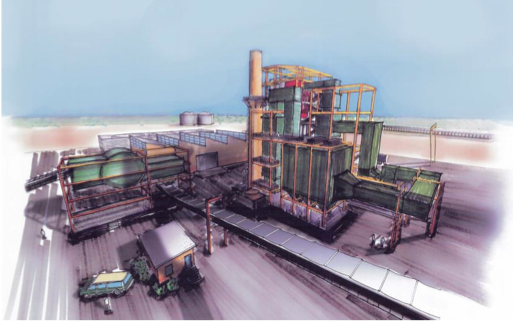 Arizona will soon be able to check another renewable energy off its list.
Arizona will soon be able to check another renewable energy off its list.
This summer Pinal Power, a utility company in Scottsdale, will began the construction of a bio mass plant that will generate electricity for 20,000 homes annually by 2014.
This is according to Hal Mitchell, the C.E.O. of Arbutus Bio Energy, and the manager of Pinal Power. The plant will cost $100 million to build of which Pinal Power will cover $40 million and the remaining $60 million will be financed.
Mitchell said that building a biomass power plant was a smart business move. “There is a need for this kind of power in this part of the country and it is a clean power,” Mitchell said.
Though solar power is the renewable energy resource that usually comes to mind in relation to Arizona, it seems that biomass energy is the emerging renewable resource for the state.
Biomass is a favorable form of energy for Arizona because the desert eco-system is abundant in materials that can be used to create biomass. The heat is perfect weather for algae growth. Also, all desert trees can be burned and converted into biomass, according to Doug Hanchett, president of Green Organics Recycling.
Green Organics is one of the companies that will be providing wood waste material for the plant. Hanchett said the company takes agricultural waste and converts the material into compost and biomass.
The plant will act as an energy generator and will not work directly with consumers. So in order for the plant to be successful, electricity companies within the area must purchase energy from Pinal Power and distribute it to customers.
 Here is how it will work: The plant will burn wood waste materials to generate steam. The steam will then be used to turn a turbine. Powered by the steam, the turbine will turn a generator and produce electricity, according to documents provided by Pinal Power.
Here is how it will work: The plant will burn wood waste materials to generate steam. The steam will then be used to turn a turbine. Powered by the steam, the turbine will turn a generator and produce electricity, according to documents provided by Pinal Power.
Mitchell said his company specializes in renewable energy, and has 32 years of experience. When asked what environment impacts the plant will have Mitchell said, “we are carbon neutral, we put in emission control equipment to make sure that the air is clean, to make sure they are no toxins being emitted.”
Hanchett said that Green Organics will be providing 38 semi-truck loads to the plant per day. The plant is projected to burn 260,000 tons of wood fuel per year.
Besides providing an environmental benefit, the plant will bring 82 new permanent jobs into Arizona. The job growth will have a ripple effect on their business partners, according to Hanchett. Green Organics will increase its work force from 22 employees to 70 to 100 employees once the plant is complete.
Though everything is set for construction, it is still unknown whether the plant will have enough companies willing to purchase power in order to sustain business. The plant plans to generate profit by selling the power to local utility companies around the state.
Electricity District 3 is a utility company that agreed to rent out power transmission lines to Pinal Power, but was not interested in purchasing power from the plant.
Bill Stacey, the general manager of Electrical District 3 said that his company was approached by Pinal Power for distribution business, but the company declined for two reasons: More than 20 percent of their energy already comes from renewable resources, and the price for power was too expensive.
Stacey explained that the cost to purchase power from Pinal Power would be 12 to 14 cents per kilowatt hour. The average price for this kind of power is 3.5 cents, according to Stacey. Pinal Power would not reveal the number of companies they plan to sell energy to, or the name of the companies.
Stacey also said that the cost is most likely to help cover transportation, and the costs that come with building a new plant.
 This may be a reason for concern since this is not the first attempt to bring biomass power to the state. A biomass plant was built in Snowflake, AZ. The company was owned by Renegy Holdings, according to Scott Harelson, a spokesman for Salt River Project.
This may be a reason for concern since this is not the first attempt to bring biomass power to the state. A biomass plant was built in Snowflake, AZ. The company was owned by Renegy Holdings, according to Scott Harelson, a spokesman for Salt River Project.
Salt River Project, a utility company in Northern Arizona, said that SRP signed a power purchase agreement in June of 2008 with the plant. It was scheduled to last 10 to 15 years. But SRP terminated their agreement after the plant filed for bankruptcy in 2010, according to Harelson.
“The facility was having some financial difficulties and frankly, was not performing as well as our expectations for it,” Harelson said.
SRP attempted to find a solution more than once, and modified the agreement to raise energy prices. After the company went bankrupt, the plant was purchased by the Najafi Brothers Company. SRP is currently under contract with the new company.
Stacey from ED3 also said that the new plant was having trouble finding companies willing to invest. But Mitchell is very confident about the success of the company, and believes that with their experience in biomass energy, the plant should be a success. “Primarily our track record is what gives us confidence about this investment. This is our 40th plant.”
Hanchett also said that though people will not be able to give waste material to the plant directly, there will be plenty of opportunities for the public to put their yard waste to use.
Once they plant is built, Green Organics will create drop off sites around the Phoenix area where members of the public can drop off their yard waste. The company will sort the products and take waste that can be used for biomass.
Hanchett said the plant will benefit the larger community because fewer items will end up in the landfills.
“Our goal is to have multiple drop-off sites for people to bring their waste in directly when they have the material. We aim to recover some of the materials that would normally go to a land fill.”








